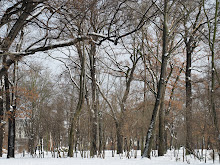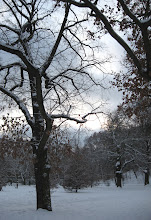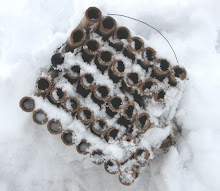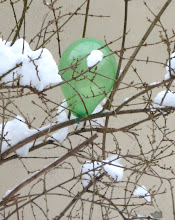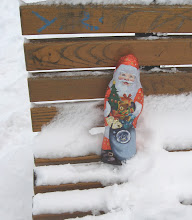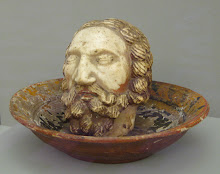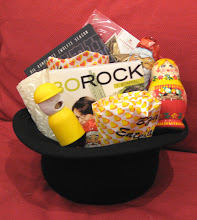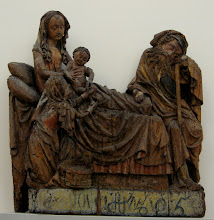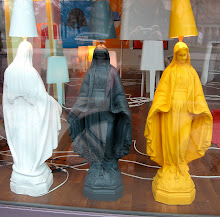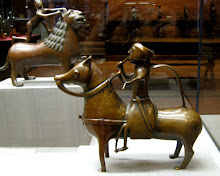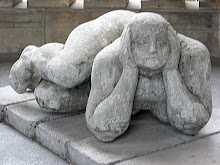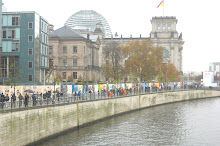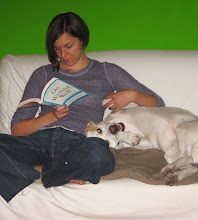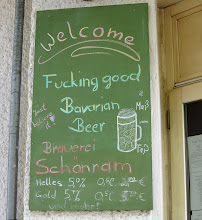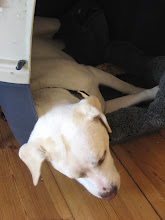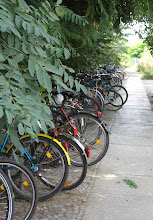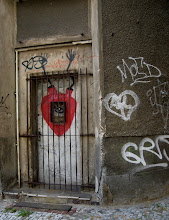OK, I admit it. I got depressed during the long icy winter and fell down the rabbit hole. It's been lonely and isolating and I turned to painting and personal writing rather than this more extroverted form of narcissism. Also I napped. I hope I'm back to blogging for a few weeks, though, as I've missed it, have a lot of things stored up to write about and am down to my last 6 weeks in Europe. Where formerly just being in Europe for 6 whole weeks at all would have been the height of luxury, after 7 months here it is starting to feel somewhat minimal and I am getting sentimental and sad about leaving. I will spend the summer in Seattle, my role changing from that of temporary ex-pat to that of mother-of-the-bride. Assuming the Icelandic volcano stops popping by the end of May and doesn't keep me stranded here...
I will re-enter the blogosphere with a brief accounting of just a few things that I will hope to pursue a bit further subsequently. We'll see how that works...
Since I hit the skids this winter I haven't done as much as I had hoped to do and am now trying like crazy to make up for a bit of it before I leave. Some of the museums here are so huge they have required multiple trips - I still haven't finished with the Deutsches Historisches Museum or the Gemäldegalerie; the Judisches Museum could take weeks. But I have made it to the Nolde and Kollwitz Museums, the Märkisches Museum, to Checkpoint Charlie, the Eastside Gallery (the longest stretch of the Wall still standing and which was repainted by something like 88 artists and just reopened to the public) and to new exhibits at the Guggenheim, the Neue Nationalgalerie, the Scharf-Gerstenberg, the Berlinische Galerie, the Hamburger Bahnhof, not to mention revisiting my old favorites a few times as well - the Bode in particular, the Pergamon, the Neues...none of which will mean anything to anyone who hasn't been here so I won't go on, but it gives me a sense of satisfaction to make these lists. I hope I wasn't an accountant in my former life, but there is a whiff of possibility there.
Occupation with words continues with more names at the dog park, my favorite new one belonging to a black pug named Zoltan. There is also a funny white bull terrier named Vanna, an enormous young Great Dane named Tennessee and an incredibly cute puggle-Jack Russell mix puppy absurdly named Bob. I have collected a few what-were-they-thinking business names as well, such as a boutique named "Ass Style," a bathroom fittings supplier called "Bad Ideen" (which just means "bathroom ideas" but has other English overtones), and of course my favorite "Titanic Travel" which I have already mentioned. (I think it is possible that the Germans came up with the name "Nova" for the Chevy that had notoriously poor sales in Latin America, "no va" meaning "no go" in Spanish.) There's a hot dog cafe called Mr. Miller's, whose darkly ambiguous tag line is "Eat Here, Diet Home." And since I find the whole idea of limousines and stretch limos repulsive, I am quite amused by the stretch Hummer I see from time to time; "hummer" is the German word for lobster which to me significantly lowers the pretense value of riding in such a vehicle. Cruising in my lobster? Maybe not so cool.
Friends are here for 10 days and it's been a great way to goose me into hyperactivity. Yesterday we started with a church service at the Dom so we could hear the organ; there was a stellar trumpet playing as well and as it was a baptism service the bishop was present, dressed in his Calvinist black robe with the white neck tabs. Very eighteenth century. We had a printed program of the service basics in English but as we opted to sit in the middle of the church rather than the small rear apse where simultaneous translation was available on earphones, we were in the aural dark for the readings and sermon. (I probably would have been anyway, even in English). It was a little bit like the Gary Larson cartoon of the guy talking to his cat and all the cat hears is her own name - "blah blah blah blah Muffy blah blah blah Muffy"; I caught the occasional German word, like Jesus and Afghanistan.
It's been a beautiful weekend after another chilly gray week and people have been out in droves, sucking up the sunlight. Saturday we went out to Grünewald, which is a lovely wooded area with a few small lakes scattered about. We walked a way in to the Teufelsee (Devil Lake) which is really just a pond but is a clothing-optional pond with the only WC for miles around. Criss-crossed by paths, roadlets and absolutely no directional signs whatsoever, we felt lucky to have found the antique tin toilet facility at all, and sat for a while pondside. We talked to a nice young man from Tennessee who thought he had made better progress than he had, working with speech coaches on his aiksent. He's here coaching kids' soccer while his wife teaches art at one of the international schools. He needs to be understood. One creepy note about the Grünewald is the very visible white dome of the old American Cold War listening post on top of one of the hills. Its covering is tattered and shredded now, and it vaguely resembles a poorly designed stage set of the Taj Mahal that has been left to rot like an old circus tent. I find the phrase "listening post" to be a bit chilling. It's like that woman's voice that comes over the radio waves in the middle of the night reciting numbers ad infinitum. Creepy.
I am expecting my friends at any minute and am thinking we'll go out to Potsdam today, before the rain resumes tomorrow for the rest of their visit. I am supposed to go to Paris on Friday to meet another set of friends, so we'll see if the Eyjafjallajokull volcano will allow us all to travel by then. I am attempting to remain optimistic.
Monday, April 19, 2010
Sunday, February 14, 2010
Winter
I have not been blogging in a month. It is partly because my adventures have tapered off as Berlin has been plastered with snow and ice since Christmas, partly because I am spending more time painting and cogitating, and partly because the longer I live here the less strange and remarkable things seem. I'm pleased with my creative work, still blissfully encountering a museum or two each week, but I'm caught up also in personal work and medical issues that are simply not fodder for public blogging, at least not here.
I have met more interesting people - a screenwriter, an actor, an actress, a head chef, an art historian (17th century Italian), an importer of Chinese furnishings, a graduate student in social sciences - and continue my friendship with the marine biologist (American) I met at the Goethe Institut. He has introduced me to other interesting scientists (all so young!); we brunch at least once a month. The screenwriter is very interested in my paintings and I send him new images as I get them made; he responds with very interesting, intuitive feedback. I have lost touch with the sports psychologist.
I have a whole slew of new, sometimes-stupid-beyond-belief dog names from the dog park - Paul (for months I thought it was "Powell"), Phil, Spike, Freida, Frodo, Bones, Cacao, Jimmy, Lumpy, Carlos, Laddie, Fido, Lucy, Murphy, Suzie, Celia (Suzie and Celia are particular new favorites of Maggie's), DuBeaux, Nyla, and two more Kieras (bringing that total to seven). They are all loving the snow, which falls endlessly, it seems, and which they delight in eating and rolling in. I have given up on ever retrieving my old glasses.
The snow brings out droves of parents with children on sleds - high-centered ones, very different from the Flexible Flyers or saucers that American children travel on. The Volkspark is well used, having some great sledding hills. I have to say that I find German children for the most part to be adorable (cutest hats ever!) and well behaved, and I have never heard anyone speak sharply to a child here or exhibit any sign of anger or annoyance. Parents seem infinitely patient and infinitely delighted with their offspring, and the fathers are as much involved as the mothers. There is a cafe near me, "Cafe Paul & Paula", that caters to people with young children, and seems to be run on the principle of common sense so lacking in the States. I am often tempted to go in and offer my services as a surrogate grandmother. Children crawl on the floor and play with common toys while their parents sit at low tables drinking coffee and tea (yes! hot liquids near tiny people!), and during the holidays there were even real candles burning in hurricane lamps on the higher tables. Imagine THAT in the States, where everyone sues everyone else for the slightest mishap they themselves might have prevented. Oh, sometimes I dread going back to that particular brand of insanity. Others, too...
The lack of threat of civil suits here has a downside, however, at least in this weather. Apparently it is quite unclear as to who is responsible for the state of the sidewalks - the city, the building owner, the tenant, or manager - so everyone is reluctant to spend their resources in dealing with the ever-increasing ice-scape that is developing through this winter of snow-snow-snow-freeeeeeeze-melt-freeeeeze-snow-snow-freeeeeze-melt-freeze. In some (most) areas it's like trying to walk on a Lilliputian version of the Himalayas. The clinics and ERs are stuffed with people who have fallen. I've fallen once myself - no injury except to my sense of equilibrium. There's no point in embarrassment, as everyone else is falling, too. There are varying degrees of effort made to sprinkle sand and gravel, but by not clearing it all up after the first big snowfall at Christmas, they have allowed it to pack unevenly and freeze over to a point where it now requires major labor with pickaxes and shovels to budge any of it. Some cars which haven't been moved in weeks, are now cratered by at least 8" walls of ice and couldn't be moved without a tow truck. They've run out of salt for the roads and are now importing it from Morocco, and some weather reports say this will last through March. It does keep the maniacal bicyclists off the sidewalks, for the most part, but the joggers keep jogging and the baby strollers keep strolling. I do find the white landscape to be bright and cheerful, much preferable to the darkness of soggy winter mud, so I'm not entirely disheartened by it all, only to the extent that it discourages me from getting out and about as much as I would like. I feel like I live in Narnia under the rule of the Ice Queen.
But not getting out and about means I am spending more time painting, and listening to audiobooks and podcasts as I work. Anyone who's ever read Julia Cameron knows about "morning pages" and these I write assiduously. This combination of painting and writing is allowing me to move great quantities of psychic baggage from the overloaded storage unit in my brain and fling it out into whatever receptacle the universe provides for such detritus. May I please never see any of it again. And if Berlin isn't the most symbolically perfect place to be undertaking this labor of personal integration, I don't know what is.
I have met more interesting people - a screenwriter, an actor, an actress, a head chef, an art historian (17th century Italian), an importer of Chinese furnishings, a graduate student in social sciences - and continue my friendship with the marine biologist (American) I met at the Goethe Institut. He has introduced me to other interesting scientists (all so young!); we brunch at least once a month. The screenwriter is very interested in my paintings and I send him new images as I get them made; he responds with very interesting, intuitive feedback. I have lost touch with the sports psychologist.
I have a whole slew of new, sometimes-stupid-beyond-belief dog names from the dog park - Paul (for months I thought it was "Powell"), Phil, Spike, Freida, Frodo, Bones, Cacao, Jimmy, Lumpy, Carlos, Laddie, Fido, Lucy, Murphy, Suzie, Celia (Suzie and Celia are particular new favorites of Maggie's), DuBeaux, Nyla, and two more Kieras (bringing that total to seven). They are all loving the snow, which falls endlessly, it seems, and which they delight in eating and rolling in. I have given up on ever retrieving my old glasses.
The snow brings out droves of parents with children on sleds - high-centered ones, very different from the Flexible Flyers or saucers that American children travel on. The Volkspark is well used, having some great sledding hills. I have to say that I find German children for the most part to be adorable (cutest hats ever!) and well behaved, and I have never heard anyone speak sharply to a child here or exhibit any sign of anger or annoyance. Parents seem infinitely patient and infinitely delighted with their offspring, and the fathers are as much involved as the mothers. There is a cafe near me, "Cafe Paul & Paula", that caters to people with young children, and seems to be run on the principle of common sense so lacking in the States. I am often tempted to go in and offer my services as a surrogate grandmother. Children crawl on the floor and play with common toys while their parents sit at low tables drinking coffee and tea (yes! hot liquids near tiny people!), and during the holidays there were even real candles burning in hurricane lamps on the higher tables. Imagine THAT in the States, where everyone sues everyone else for the slightest mishap they themselves might have prevented. Oh, sometimes I dread going back to that particular brand of insanity. Others, too...
The lack of threat of civil suits here has a downside, however, at least in this weather. Apparently it is quite unclear as to who is responsible for the state of the sidewalks - the city, the building owner, the tenant, or manager - so everyone is reluctant to spend their resources in dealing with the ever-increasing ice-scape that is developing through this winter of snow-snow-snow-freeeeeeeze-melt-freeeeeze-snow-snow-freeeeeze-melt-freeze. In some (most) areas it's like trying to walk on a Lilliputian version of the Himalayas. The clinics and ERs are stuffed with people who have fallen. I've fallen once myself - no injury except to my sense of equilibrium. There's no point in embarrassment, as everyone else is falling, too. There are varying degrees of effort made to sprinkle sand and gravel, but by not clearing it all up after the first big snowfall at Christmas, they have allowed it to pack unevenly and freeze over to a point where it now requires major labor with pickaxes and shovels to budge any of it. Some cars which haven't been moved in weeks, are now cratered by at least 8" walls of ice and couldn't be moved without a tow truck. They've run out of salt for the roads and are now importing it from Morocco, and some weather reports say this will last through March. It does keep the maniacal bicyclists off the sidewalks, for the most part, but the joggers keep jogging and the baby strollers keep strolling. I do find the white landscape to be bright and cheerful, much preferable to the darkness of soggy winter mud, so I'm not entirely disheartened by it all, only to the extent that it discourages me from getting out and about as much as I would like. I feel like I live in Narnia under the rule of the Ice Queen.
But not getting out and about means I am spending more time painting, and listening to audiobooks and podcasts as I work. Anyone who's ever read Julia Cameron knows about "morning pages" and these I write assiduously. This combination of painting and writing is allowing me to move great quantities of psychic baggage from the overloaded storage unit in my brain and fling it out into whatever receptacle the universe provides for such detritus. May I please never see any of it again. And if Berlin isn't the most symbolically perfect place to be undertaking this labor of personal integration, I don't know what is.
Saturday, January 16, 2010
Grim Reapings
I've said before that it is startling to find myself, an American child of the Cold War, living happily not only in Germany, not only in Berlin, but in east Berlin, place of the double-whammy: from Nazi to Soviet, and that's only going back a war or two. Never mind the mess the Kaiser made.
Although we never talked about the War at home, we did know that my father had lost his three best friends to the Germans, and culturally I was raised with the still-fairly-fresh war stories of those who did talk about it, and write about it, and put it on television. Even cartoons had their mad scientist characters with sinister German accents and white lab coats. I learned to think of the Germans as the evil race, bloodthirsty Nazis all, with harsh accents and harsher faces, goose-stepping and heiling through so many of the movies of my younger years. Judging by the number of mind-numbing war-movie dates I went on in high school, at least the boys I grew up with had an insatiable voyeuristic appetite for this recent and ghastly past. In addition to the Hollywood spin, at some point in high school I heard part of a transcription of graphic testimony from the Nuremburg trials that gave me nightmares for years. We moved into Viet Nam, but The War never went away. In my thirties it revisited my consciousness as Herman Wouk's extraordinary books "The Winds of War" and "War and Remembrance," then the mini-series.
(My own maternal great-grandparents were both German, first-generation midwesterners in a tiny town in Illinois; they named their 8 children such American favorites as Ralph Waldo and James Blaine; there was also a Roy Valentine and a Cedric Montgomery; hardly a whiff of German. They even Americanized the family name from Schneider to Snyder. And of course their parents had had the good sense to emigrate long before any of this particular ugliness was in the works and were therefore exempt from the racial blame of the post-war decades.)
By the time I was in grade school, of course, the Russians had taken their place as the new menace in our collective psyche. The Cold War brought the ever-present threat of The Bomb, which was articulated for us every Wednesday noon by the testing of the air raid sirens and was also taken up - very profitably - in a whole new array of plotlines by film and television producers, the old German faces and accents blurring into the new ones of the Soviets. In 1961, when the Wall went up dividing Berlin, I was nine years old. I remember the stark black-and-white TV footage of the 11 o'clock news report my parents watched the night it was completed, but it was their fear and the grim atmosphere of our living room that was truly frightening. (The only other late-night news report that imprinted itself on my young brain was almost exactly a year later when Marilyn Monroe was found dead. And then of course, it was only about a year after that that JFK was shot and childhood was just over.) In the sixth grade we were made to watch documentary footage of Russian soldiers shooting people who fell into an open mass grave, probably something to do with the Russian Revolution so we could see just how vicious these people were. Why anyone thought this was appropriate for young schoolchildren I will never know. (Propaganda: Frighten early, and often.) More fodder for years of nightmares. Newsreels of Soviet arms parades were, of course, a staple at the movie theater. It was hard to grasp how we could have just been wartime allies, fighting the Nazis, with these people we now feared with every breath.
In early November, the day of the Wall-Fall celebration, I finally wandered through the Holocaust Memorial which sits behind the U.S. Embassy in what was the death strip between East and West. It is nearly 5 acres of sarcophagus-size concrete chunks of varying heights, laid out in a grid that tilts a bit to create an intended feeling of being off-balance, a world gone awry. Designed by American (!) architect Peter Eisenman, it has the feel of a stark necropolis, a somber acknowledgment that Nazi Germany exterminated 6 million Jews. In spite of the optimistic view of a dear friend, who is inspired to play hide-and-seek in here and sees this as a positive legacy, I am inspired only to mourn.
At Thanksgiving, when my brother and sister-in-law were here, we visited the Berlin Wall Documentation Center which is near the Church of Reconciliation - an 1894 structure that ended up in the wide no-man's-land between East and West, sealed off from its congregation, and finally razed by the Communists in 1985. The congregation got its property back after the Wall came down and put up a new chapel. Across the street, facing the longest remaining segment of the Wall, is the Documentation Center, which houses a permanent exhibition (which we did not explore) and a viewing tower (which we did) that gives you perspective on just how wide the death strip was and how the Wall affected an individual neighborhood. We learned that the Wall was modified to prevent breaching by automotive vehicles through the addition of a long, sloping foot at the base. If a truck tried to ram its way through, the weight of the truck on this foot would prevent the wall from falling in the opposite direction. This memorial is still being developed, but there is a good outside display of the Wall's history and of the plans for the completion of the complex. I can only absorb so much of this stuff in one day (poor me); it is all so sad. It has taken me about three weeks just to complete this blog entry.
At Christmas I was invited to join the Berlin ice hockey team on a tour of one of the underground bunkers renovated during World War II as a public air-raid shelter. (Many of these had been constructed during WWI as protection against poison gas attacks.) Berlin's population in 1945 had not yet hit 3 million, but it was close; this bunker could only hold about 1,000 people during a raid, and probably was not even deep enough nor safe enough to be an effective shelter had it been hit. The walls are coated in phosphorescent paint (we were warned not to lick them) and still glow for a while when the lights are turned off and most of the original signs are still in place, pointing to the segregated bathrooms and to the Mothers-and-Children room. There's apparently even a birthing room, but we didn't see it. People sat on backless wooden benches in small rooms of 20-40 people, for 7 or 8 hours at a time, and when they were released, depending upon the success of the raid, they came out to streets strewn with body parts, dead children, obliterated homes. They learned to wear their fur coats, if they had them, and to bring all their papers and valuables with them in suitcases, and to sit on the suitcases. It was pitch dark once the paint stopped glowing and theft was easy and rampant.
(The War still intrudes here from time to time when pieces of unexploded ordnance are encountered by farmers, construction workers, and survey crews. In 1997 a bomb went off in the neighborhood I now live in, killing 3 people. Just a few weeks ago a 500-kilo bomb, discovered near Bremen, was safely moved to a "detonation area" after 8,500 people were evacuated. It's estimated that about 20 tons of the stuff is still found each year - bombs, mines, grenades which sank into the soft German soil.)
When the Soviets moved in after the war, things did not go well for the Easterners, especially for the women. In addition to the 6 million Jews, the Nazis had also killed 12 million Russians. The Russians pulled their soldiers from wherever they could find young men, many of them young, uneducated boys from the vast rural countryside, coerced into service with guns at their heads. Needless to say, when they got their piece of Germany they were in a very vengeful frame of mind. They systematically raped at least 90% of the women here, many of them multiple times, for years. And yet, when things settled down, the women in the socialist system encountered a more equal distribution of labor. Yes, they may have had crummy government jobs - that's about all there was after all the industry moved out of Berlin - but they had as many jobs as their male counterparts. And the men helped with the housework and childcare, an ethic that looks to be still firmly in place, judging by the number of men I see pushing baby strollers and playing with their children in the park every day. I find it an interesting statistic that one in eight Germans - Westerners and Easterners alike - would prefer to go back to the old segregated system.
Now I have done my duty to myself by recording all this. I will happily go back to the art museums this week.
Although we never talked about the War at home, we did know that my father had lost his three best friends to the Germans, and culturally I was raised with the still-fairly-fresh war stories of those who did talk about it, and write about it, and put it on television. Even cartoons had their mad scientist characters with sinister German accents and white lab coats. I learned to think of the Germans as the evil race, bloodthirsty Nazis all, with harsh accents and harsher faces, goose-stepping and heiling through so many of the movies of my younger years. Judging by the number of mind-numbing war-movie dates I went on in high school, at least the boys I grew up with had an insatiable voyeuristic appetite for this recent and ghastly past. In addition to the Hollywood spin, at some point in high school I heard part of a transcription of graphic testimony from the Nuremburg trials that gave me nightmares for years. We moved into Viet Nam, but The War never went away. In my thirties it revisited my consciousness as Herman Wouk's extraordinary books "The Winds of War" and "War and Remembrance," then the mini-series.
(My own maternal great-grandparents were both German, first-generation midwesterners in a tiny town in Illinois; they named their 8 children such American favorites as Ralph Waldo and James Blaine; there was also a Roy Valentine and a Cedric Montgomery; hardly a whiff of German. They even Americanized the family name from Schneider to Snyder. And of course their parents had had the good sense to emigrate long before any of this particular ugliness was in the works and were therefore exempt from the racial blame of the post-war decades.)
By the time I was in grade school, of course, the Russians had taken their place as the new menace in our collective psyche. The Cold War brought the ever-present threat of The Bomb, which was articulated for us every Wednesday noon by the testing of the air raid sirens and was also taken up - very profitably - in a whole new array of plotlines by film and television producers, the old German faces and accents blurring into the new ones of the Soviets. In 1961, when the Wall went up dividing Berlin, I was nine years old. I remember the stark black-and-white TV footage of the 11 o'clock news report my parents watched the night it was completed, but it was their fear and the grim atmosphere of our living room that was truly frightening. (The only other late-night news report that imprinted itself on my young brain was almost exactly a year later when Marilyn Monroe was found dead. And then of course, it was only about a year after that that JFK was shot and childhood was just over.) In the sixth grade we were made to watch documentary footage of Russian soldiers shooting people who fell into an open mass grave, probably something to do with the Russian Revolution so we could see just how vicious these people were. Why anyone thought this was appropriate for young schoolchildren I will never know. (Propaganda: Frighten early, and often.) More fodder for years of nightmares. Newsreels of Soviet arms parades were, of course, a staple at the movie theater. It was hard to grasp how we could have just been wartime allies, fighting the Nazis, with these people we now feared with every breath.
In early November, the day of the Wall-Fall celebration, I finally wandered through the Holocaust Memorial which sits behind the U.S. Embassy in what was the death strip between East and West. It is nearly 5 acres of sarcophagus-size concrete chunks of varying heights, laid out in a grid that tilts a bit to create an intended feeling of being off-balance, a world gone awry. Designed by American (!) architect Peter Eisenman, it has the feel of a stark necropolis, a somber acknowledgment that Nazi Germany exterminated 6 million Jews. In spite of the optimistic view of a dear friend, who is inspired to play hide-and-seek in here and sees this as a positive legacy, I am inspired only to mourn.
At Thanksgiving, when my brother and sister-in-law were here, we visited the Berlin Wall Documentation Center which is near the Church of Reconciliation - an 1894 structure that ended up in the wide no-man's-land between East and West, sealed off from its congregation, and finally razed by the Communists in 1985. The congregation got its property back after the Wall came down and put up a new chapel. Across the street, facing the longest remaining segment of the Wall, is the Documentation Center, which houses a permanent exhibition (which we did not explore) and a viewing tower (which we did) that gives you perspective on just how wide the death strip was and how the Wall affected an individual neighborhood. We learned that the Wall was modified to prevent breaching by automotive vehicles through the addition of a long, sloping foot at the base. If a truck tried to ram its way through, the weight of the truck on this foot would prevent the wall from falling in the opposite direction. This memorial is still being developed, but there is a good outside display of the Wall's history and of the plans for the completion of the complex. I can only absorb so much of this stuff in one day (poor me); it is all so sad. It has taken me about three weeks just to complete this blog entry.
At Christmas I was invited to join the Berlin ice hockey team on a tour of one of the underground bunkers renovated during World War II as a public air-raid shelter. (Many of these had been constructed during WWI as protection against poison gas attacks.) Berlin's population in 1945 had not yet hit 3 million, but it was close; this bunker could only hold about 1,000 people during a raid, and probably was not even deep enough nor safe enough to be an effective shelter had it been hit. The walls are coated in phosphorescent paint (we were warned not to lick them) and still glow for a while when the lights are turned off and most of the original signs are still in place, pointing to the segregated bathrooms and to the Mothers-and-Children room. There's apparently even a birthing room, but we didn't see it. People sat on backless wooden benches in small rooms of 20-40 people, for 7 or 8 hours at a time, and when they were released, depending upon the success of the raid, they came out to streets strewn with body parts, dead children, obliterated homes. They learned to wear their fur coats, if they had them, and to bring all their papers and valuables with them in suitcases, and to sit on the suitcases. It was pitch dark once the paint stopped glowing and theft was easy and rampant.
(The War still intrudes here from time to time when pieces of unexploded ordnance are encountered by farmers, construction workers, and survey crews. In 1997 a bomb went off in the neighborhood I now live in, killing 3 people. Just a few weeks ago a 500-kilo bomb, discovered near Bremen, was safely moved to a "detonation area" after 8,500 people were evacuated. It's estimated that about 20 tons of the stuff is still found each year - bombs, mines, grenades which sank into the soft German soil.)
When the Soviets moved in after the war, things did not go well for the Easterners, especially for the women. In addition to the 6 million Jews, the Nazis had also killed 12 million Russians. The Russians pulled their soldiers from wherever they could find young men, many of them young, uneducated boys from the vast rural countryside, coerced into service with guns at their heads. Needless to say, when they got their piece of Germany they were in a very vengeful frame of mind. They systematically raped at least 90% of the women here, many of them multiple times, for years. And yet, when things settled down, the women in the socialist system encountered a more equal distribution of labor. Yes, they may have had crummy government jobs - that's about all there was after all the industry moved out of Berlin - but they had as many jobs as their male counterparts. And the men helped with the housework and childcare, an ethic that looks to be still firmly in place, judging by the number of men I see pushing baby strollers and playing with their children in the park every day. I find it an interesting statistic that one in eight Germans - Westerners and Easterners alike - would prefer to go back to the old segregated system.
Now I have done my duty to myself by recording all this. I will happily go back to the art museums this week.
Saturday, January 2, 2010
Losing Things
I have now lost my glasses in 8 inches of snow at the dog park. I took them off in the twilight of New Year's Day so I could watch the intriguing ascension of a small paper hot-air balloon, fueled by some sort of live flame - I wasn't close enough to the young women who were inflating it to be able to see if it was a candle or some other special device, but whatever it was it sat high up enough into the balloon to make it glow a deep orange like an enormous pod from a Japanese lantern plant. It glowed, and drifted farther and higher for at least five minutes; I watched until it either went out or got too far away to see. I couldn't believe how far it went; I had assumed it would last 30 seconds before being extinguished and spluttering to a wobbly descent. Nor could I believe that its chief engineers didn't watch the entire performance, but they wandered away after a while, joyfully content with their moment of fun. The whole thing was magical.
(Speaking of balloons, ten years ago in Paris a boyfriend and I had been most amused by the incongruous sight of a green balloon bobbing along the street in a construction zone. Yesterday, New Year's morning, another green balloon found its way into my walled garden, where it remains parked in a twiggy shrub.)
After the hot-air balloon disappeared I was distracted by yet a third sign of celebratory New Year's whimsy (somewhat unexpected in still-dour east Berlin) - a large chocolate Santa, still fully clothed and unmolested in his foil wrapping, stuck into a mound of snow on one of the park benches. There was something so endearing and so generous in this gesture - hard to imagine myself willingly giving up anything sweet for some stranger or leaving such a token for possible removal to a garbage can by a paranoid parent. It was awfully cute. (It was still there today, only sitting on a different bench, devoid of its snow base.)
And then I lost my glasses, probably as a wildly enthusiastic young black lab leapt at the pocket in which both glasses and dog treats resided. I didn't discover the loss until I got home, by which time it was quite dark and a return trek was pointless and out of the question. St. Anthony was supposed to find and hold them for me until I got back there today, but he apparently has other plans. I think it's just possible that the great patron of lost things has in mind a new vision for me this year and that my old way of seeing, as manifested in my old bifocals, will remain lost. (Looking for them without being able to see much because, of course, I have lost my glasses, reminded me of the Ray Bradbury story of the misanthrope who sits out a nuclear war in the bowels of the city library, is ecstatic to find the rest of the human race wiped out so he can read in peace, and then obliterates his one pair of glasses in a fatal misstep.) It is also possible that they will turn up when all this snow melts, along with the earring I lost a couple months ago.
A few weeks ago I lost a glove at the farmers' market, on a VERY cold day. I retraced my steps around the circuit a couple of times with no luck - and a very cold hand - but on the third round, with Hannah in tow, I found the errant handshuh carefully placed at eye level on a fir tree at a Christmas tree stall. Thank you, St. Anthony.
At the St. Lucia concert at the Berliner Dom I lost both gloves, again on a VERY cold evening. I discovered my loss on the way out, swam back upstream to my pew without finding them, dropping my hat in the process. The gloves turned up in the vestibule, neatly placed on top of a display case, probably dropped when I arrived for the concert and was hunting for my ticket. St. Anthony has my undying devotion.
I have also dropped a hat at the dog park, retrieved by Mocha, a young chocolate lab, and a glove, joyfully borrowed for a quick romp by Fattska, the puggle puppy. I left a hat behind at a museum cloak room and had to go back for it. I lost my wallet at the grocery store. I locked my keys inside my apartment. I lost Maggie's leash one day, also in the snow at the dog park. I have lost track of my German online-banking pin three times. I lost a Visa card before I even got here, although I think it's safely locked up in my shed at home. I am finding it harder and harder to keep track of what little German I've learned. I have lost any motivation to do ANYTHING. Some days I feel I am losing my entire mind except the part that mandates food intake. St. Anthony does not seem to be helping much in that department.
On the flip side, I have now found a total of €21.79 and a quite useless 2-Deutschemark coin, although I suppose it is entirely possible that at least one of the €5 notes I have found was one I had dropped myself. I choose to believe otherwise. I must have SOME dignity left, especially after stooping to pick up so many 1¢ coppers off the sidewalks.
(Speaking of balloons, ten years ago in Paris a boyfriend and I had been most amused by the incongruous sight of a green balloon bobbing along the street in a construction zone. Yesterday, New Year's morning, another green balloon found its way into my walled garden, where it remains parked in a twiggy shrub.)
After the hot-air balloon disappeared I was distracted by yet a third sign of celebratory New Year's whimsy (somewhat unexpected in still-dour east Berlin) - a large chocolate Santa, still fully clothed and unmolested in his foil wrapping, stuck into a mound of snow on one of the park benches. There was something so endearing and so generous in this gesture - hard to imagine myself willingly giving up anything sweet for some stranger or leaving such a token for possible removal to a garbage can by a paranoid parent. It was awfully cute. (It was still there today, only sitting on a different bench, devoid of its snow base.)
And then I lost my glasses, probably as a wildly enthusiastic young black lab leapt at the pocket in which both glasses and dog treats resided. I didn't discover the loss until I got home, by which time it was quite dark and a return trek was pointless and out of the question. St. Anthony was supposed to find and hold them for me until I got back there today, but he apparently has other plans. I think it's just possible that the great patron of lost things has in mind a new vision for me this year and that my old way of seeing, as manifested in my old bifocals, will remain lost. (Looking for them without being able to see much because, of course, I have lost my glasses, reminded me of the Ray Bradbury story of the misanthrope who sits out a nuclear war in the bowels of the city library, is ecstatic to find the rest of the human race wiped out so he can read in peace, and then obliterates his one pair of glasses in a fatal misstep.) It is also possible that they will turn up when all this snow melts, along with the earring I lost a couple months ago.
A few weeks ago I lost a glove at the farmers' market, on a VERY cold day. I retraced my steps around the circuit a couple of times with no luck - and a very cold hand - but on the third round, with Hannah in tow, I found the errant handshuh carefully placed at eye level on a fir tree at a Christmas tree stall. Thank you, St. Anthony.
At the St. Lucia concert at the Berliner Dom I lost both gloves, again on a VERY cold evening. I discovered my loss on the way out, swam back upstream to my pew without finding them, dropping my hat in the process. The gloves turned up in the vestibule, neatly placed on top of a display case, probably dropped when I arrived for the concert and was hunting for my ticket. St. Anthony has my undying devotion.
I have also dropped a hat at the dog park, retrieved by Mocha, a young chocolate lab, and a glove, joyfully borrowed for a quick romp by Fattska, the puggle puppy. I left a hat behind at a museum cloak room and had to go back for it. I lost my wallet at the grocery store. I locked my keys inside my apartment. I lost Maggie's leash one day, also in the snow at the dog park. I have lost track of my German online-banking pin three times. I lost a Visa card before I even got here, although I think it's safely locked up in my shed at home. I am finding it harder and harder to keep track of what little German I've learned. I have lost any motivation to do ANYTHING. Some days I feel I am losing my entire mind except the part that mandates food intake. St. Anthony does not seem to be helping much in that department.
On the flip side, I have now found a total of €21.79 and a quite useless 2-Deutschemark coin, although I suppose it is entirely possible that at least one of the €5 notes I have found was one I had dropped myself. I choose to believe otherwise. I must have SOME dignity left, especially after stooping to pick up so many 1¢ coppers off the sidewalks.
Pinball
After as dreary and dismal a day as yesterday (Christmas) was, today was sunny again and finally the ice is all melted from the sidewalks and streets. I miss the snow, but not its gradual trajectory into frozen death-traps and the inevitable piles of grit. It's particularly treacherous on all the slick granite cobblestones a lot of the paving here comprises. I will hope for more snow this winter; Maggie adores it and I find it so much cheerier than sludge. Besides, it fits my fantasy of winter in Germany.
Watching Maggie in the dog park this evening was like watching a rerun of my own afternoon at the Deutsches Historisches Museum. I finally appreciate what she is up to when she smells bush after bush, digs a little in a mud puddle, wanders over to the fence for a good sniff, moves some sticks around, snuffles under a pile of leaves, and moves on to yet another bush. The bushes all look the same to me, but Maggie knows better.
Today was my first visit to this historical museum. I need some new territory to prowl around and mark as my own, and there is a LOT of acreage at this one. I stayed within the confines of the medieval period, which was all my eyeballs could take in in a two-hour period, and is my favorite, anyway. I snooped happily among the pieces of pottery and woodcut books, avoided the armor for the most part although I was drawn to the paint-encrusted leather battle shields, and bounced like a pinball marble from Cranach portrait to Dürer portrait, back to Cranach, on to a huge carved wedding chest and an Imperial edict of some sort with a fringe of huge wax seals along the bottom. Another Cranach. A gold folding pocket sundial. A Bosch. A Breughel or two. (Some more Baby Jesuses but I didn't have my camera with me.) The place is a wonderland, and beautifully laid out. I will probably have to get a yearlong membership there as well. It would pay for itself in a few short months. Oh, but wait. I don't have a year left here any more. Just 7 months as I will be home by the end of July for my younger daughter's wedding in mid-August. Unless I come back after that for a second year...
Watching Maggie in the dog park this evening was like watching a rerun of my own afternoon at the Deutsches Historisches Museum. I finally appreciate what she is up to when she smells bush after bush, digs a little in a mud puddle, wanders over to the fence for a good sniff, moves some sticks around, snuffles under a pile of leaves, and moves on to yet another bush. The bushes all look the same to me, but Maggie knows better.
Today was my first visit to this historical museum. I need some new territory to prowl around and mark as my own, and there is a LOT of acreage at this one. I stayed within the confines of the medieval period, which was all my eyeballs could take in in a two-hour period, and is my favorite, anyway. I snooped happily among the pieces of pottery and woodcut books, avoided the armor for the most part although I was drawn to the paint-encrusted leather battle shields, and bounced like a pinball marble from Cranach portrait to Dürer portrait, back to Cranach, on to a huge carved wedding chest and an Imperial edict of some sort with a fringe of huge wax seals along the bottom. Another Cranach. A gold folding pocket sundial. A Bosch. A Breughel or two. (Some more Baby Jesuses but I didn't have my camera with me.) The place is a wonderland, and beautifully laid out. I will probably have to get a yearlong membership there as well. It would pay for itself in a few short months. Oh, but wait. I don't have a year left here any more. Just 7 months as I will be home by the end of July for my younger daughter's wedding in mid-August. Unless I come back after that for a second year...
Subscribe to:
Comments (Atom)

